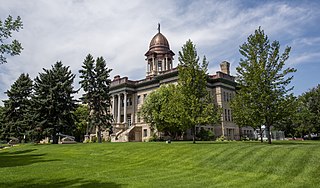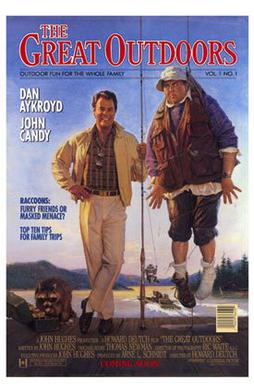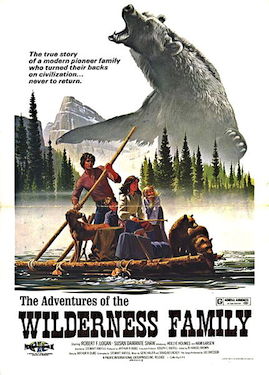
Cascade County is a county located in the U.S. state of Montana. As of the 2020 census, the population was 84,414, making it the fifth-most populous county in Montana. Its county seat is Great Falls.

Great Falls is the third most populous city in the U.S. state of Montana and the county seat of Cascade County. The population was 60,442 according to the 2020 census. The city covers an area of 22.9 square miles (59 km2) and is the principal city of the Great Falls, Montana, Metropolitan Statistical Area, which encompasses all of Cascade County. The Great Falls MSA's population stood at 84,414 in the 2020 census.

The Bob Marshall Wilderness Area is a congressionally-designated wilderness area located in Western Montana region of the United States. It is named after Bob Marshall (1901–1939), an early forester in the federal government, conservationist, and co-founder of The Wilderness Society. In the 1930s while working for the Forest Service, Marshall was largely responsible for designation of large areas to be preserved as roadless within lands administered by the Forest Service; he achieved this through promulgation of various regulations. Formally designated in 1964, the Bob Marshall Wilderness extends for 60 miles (97 km) along the Continental Divide and consists of 1,009,356 acres (4,084.72 km2).

The Gallatin National Forest is a United States National Forest located in South-West Montana. Most of the Custer-Gallatin goes along the state's southern border, with some of it a part of North-West Wyoming.

Missi Pyle is an American actress and singer. She has appeared in a number of films, including Galaxy Quest (1999), Josie and the Pussycats (2001), Bringing Down the House (2003), Dodgeball: A True Underdog Story (2004), Charlie and the Chocolate Factory (2005), Harold & Kumar Escape from Guantanamo Bay (2008), The Artist (2011), Gone Girl (2014), Captain Fantastic (2016), and Ma (2019).
The Charles M. Russell National Wildlife Refuge is a National Wildlife Refuge in the U.S. state of Montana on the Missouri River. The refuge surrounds Fort Peck Reservoir and is 915,814 acres (3,706.17 km2) in size. It is the second-largest National Wildlife Refuge in the lower 48 states of the United States, and the largest in Montana. Created in 1936, it was originally called the Fort Peck Game Range. It was renamed in 1963 after Montana artist Charles M. Russell, a famous painter of the American West. In 1976, the "range" was made a "refuge".

The Great Outdoors is a 1988 American comedy film directed by Howard Deutch, written and produced by John Hughes, and starring Dan Aykroyd and John Candy with supporting roles done by Stephanie Faracy, Annette Bening, Chris Young, Lucy Deakins, and Robert Prosky. The film is about two families spending a vacation at a fictional resort town in northern Wisconsin. Aykroyd, Candy, and Young reprise their roles from Hughes' previous film, She's Having a Baby.

The Adventures of the Wilderness Family is a 1975 American family adventure drama film directed by Stewart Raffill and starring Robert Logan, George Buck Flower and Susan Damante-Shaw. The film is about Skip Robinson and his family who decide to move from Los Angeles, California to a new home in the majestic Rocky Mountains, Skip builds a log cabin, and the children befriend wild animals. As the intrepid Robinsons make a simpler life for themselves off the grid, they discover that, in the wilderness, each day brings its own adventure.
C. M. Russell Museum Complex is an art museum located in the city of Great Falls, Montana, in the United States. The museum's primary function is to display the artwork of Great Falls "cowboy artist" Charles Marion Russell, for whom the museum is named. The museum also displays illustrated letters by Russell, work materials used by him, and other items which help visitors understand the life and working habits of Russell. In addition, the museum displays original 19th, 20th, and 21st century art depicting the American Old West and the flora, fauna, and landscapes of the American West. In 2009, the Wall Street Journal called the institution "one of America's premier Western art museums." Located on the museum property is Russell's log cabin studio, as well as his two-story wood-frame home. The house and log cabin studio were designated a National Historic Landmark in 1965, and added to the National Register of Historic Places in 1966. In 1976, the listing boundaries were amended to account for moving the house.

Perils of the Wilderness is a 1956 American Western serial film directed by Spencer Gordon Bennet and starring Dennis Moore.

Holter Dam is a hydroelectric straight gravity dam on the Missouri River about 45 miles (72 km) northeast of Helena, Montana, in the United States. The dam, which was built between 1908 and 1918, is 1,364 feet (416 m) long and 124 feet (38 m) high. The reservoir formed by the dam, Holter Lake is 25 miles (40 km) long and has a storage capacity of 243,000 acre-feet (300,000,000 m3) of water when full. The dam is a "run-of-the-river" dam because it can generate electricity without needing to store additional water supplies behind the dam.
Sleeping Giant Wilderness Study Area is a non-motorized recreation area located on the west side of the Missouri River and Holter Lake located about 30 miles (48 km) north of Helena, Montana. Designated as a wilderness study area in 1981, the Sleeping Giant Wilderness Study Area contains approximately 6,666 acres (2,698 ha) of nearly roadless land, about half of which is forested. A portion of the Lewis and Clark National Historic Trail is contained inside the study area.
Brutus, also called Brutus the Bear, was a grizzly bear who was adopted as a newborn cub by the naturalist Casey Anderson, star of the National Geographic documentary Expedition Grizzly.

Black Eagle Dam is a hydroelectric gravity weir dam located on the Missouri River in the city of Great Falls, Montana. The first dam on the site, built and opened in 1890, was a timber-and-rock crib dam. This structure was the first hydroelectric dam built in Montana and the first built on the Missouri River. The dam helped give the city of Great Falls the nickname "The Electric City." A second dam, built of concrete in 1926 and opened in 1927, replaced the first dam, which was not removed and lies submerged in the reservoir. Almost unchanged since 1926, the dam is 782 feet (238 m) long and 34.5 feet (10.5 m) high, and its powerhouse contains three turbines capable of generating seven megawatts (MW) of power each. The maximum power output of the dam is 18 MW. Montana Power Company built the second dam, PPL Corporation purchased it in 1997 and sold it to NorthWestern Corporation in 2014. The reservoir behind the dam has no official name, but was called the Long Pool for many years. The reservoir is about 2 miles (3.2 km) long, and has a storage capacity of 1,710 acre-feet (2,110,000 m3) to 1,820 acre-feet (2,240,000 m3) of water.

Great Falls High School is a public high school for grades 9 through 12 located in Great Falls, Montana. Established in 1890, it was the city's first high school. The school's original building, constructed in 1896, is now on the National Register of Historic Places. GFHS began construction on its current building in 1929 and occupied it in the fall of 1930. The high school marked its 80th year in the structure during the 2010–2011 school year. The school's current building, constructed in 1930, was added to the National Register of Historic Places in March 2013.

Paris Gibson Square Museum of Art is an art museum located at 1400 First Avenue North in Great Falls, Montana, in the United States. The building was constructed in 1896 to house the city's first high school, Great Falls High School. The high school moved to new quarters in 1931, at which time the building was renamed Paris Gibson Junior High School. The junior high school vacated the premises in 1975 for a new building. In 1977, Paris Gibson Square Museum of Art was formed, and it took ownership of the building. It is one of six museums in the city. The structure was listed on the National Register of Historic Places in September 1976.
Operating as a nonprofit environmental land trust, The Vital Ground Foundation protects and restores North America's grizzly bear populations by conserving wildlife habitat. Founded in 1990, Vital Ground operates in the belief that the grizzly bear, an umbrella species, is nature's barometer of a healthy and complete ecosystem, and that conserving grizzly bears and their habitat is key to ensuring diverse and healthy landscapes.

Casey Anderson is an American filmmaker, wildlife naturalist, and television presenter known for translating human relationships with the natural world and wild animals to various audiences. He has been a host and executive producer of the Nat Geo WILD channel television series, Expedition Wild and America the Wild with Casey Anderson, and for raising Brutus the Bear, a grizzly bear that he rescued and adopted as a newborn cub. Brutus and Anderson have appeared in many films, documentaries, television commercials, and live educational shows across the United States.
Frank Cooper Craighead Jr. and John Johnson Craighead, twin brothers, were American conservationists, naturalists, and researchers who made important contributions to the studies of falconry and grizzly bear biology. The brothers were born in Washington, D.C., where both graduated from Western High School in 1935. The brothers began collecting and identifying animals and plants they found alongside the Potomac and soon expanded their interests to birds and hawks. They traveled west in 1934 to begin studying falconry. After World War II, during which they were employed as survival trainers, they each married and resumed their work in falconry. During the 1950s, the Craighead brothers expanded their work to other animals, including many species living in and around Yellowstone, and eventually separated.













